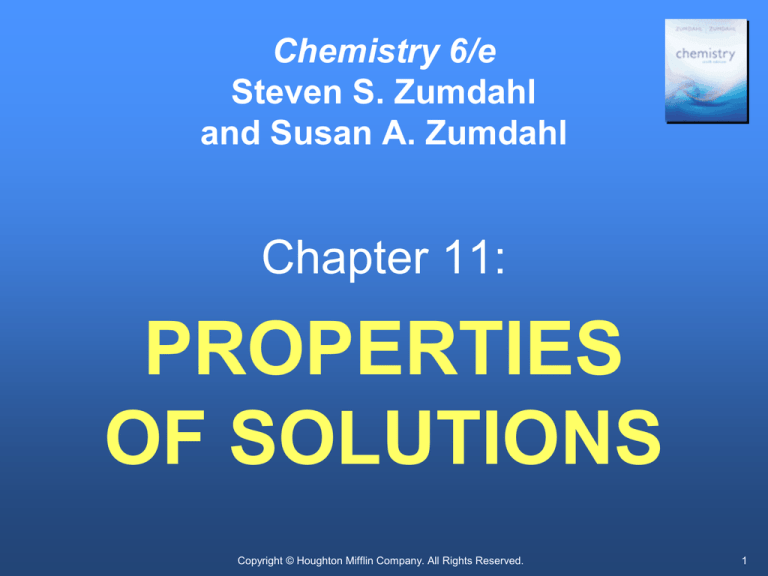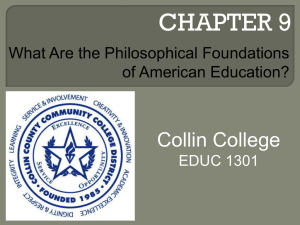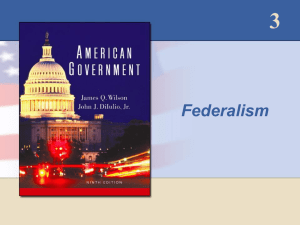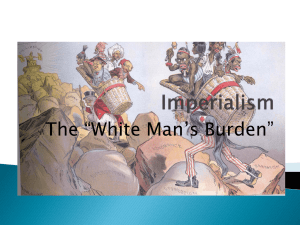
Chemistry 6/e
Steven S. Zumdahl
and Susan A. Zumdahl
Chapter 11:
PROPERTIES
OF SOLUTIONS
Copyright © Houghton Mifflin Company. All Rights Reserved.
1
Properties of Solutions
• Solution Composition
• React 1
• The Energies of
Solution Formation
• React 2
• Factors Affecting
Solubility
• The Vapor Pressure
of Solutions
• React 3 • 4
• Nonideal Solutions
• React 5 • 6
• Boiling-Point Elevation
and Freezing-Point
Depression
• React 7 • 8 • 9
• React 10 • 11
• Osmotic Pressure
• React 12 • 13
Copyright © Houghton Mifflin Company. All Rights Reserved.
2
Various Types of Solutions
State of
Solution
Gas
State of
Solute
Gas
State of
Solvent
Gas
Vodka in water, antifreeze Liquid
Liquid
Liquid
Brass
Carbonated water (soda)
Seawater, sugar solution
Solid
Liquid
Liquid
Solid
Gas
Solid
Solid
Liquid
Liquid
Hydrogen in platinum
Solid
Gas
Solid
Example
Air, natural gas
Copyright © Houghton Mifflin Company. All Rights Reserved.
3
Solution Composition
Copyright © Houghton Mifflin Company. All Rights Reserved.
4
Consider two aqueous solutions, A and B
(which contain different solutes).
Is it possible for solution A to have a greater
concentration than solution B in terms of mass
percent, but a smaller concentration in terms of
molarity? If no, explain why not. If yes, provide
an example.
What if the solutions contained the same
solute?
Copyright © Houghton Mifflin Company. All Rights Reserved.
5
The Energies of Solution
Formation
Copyright © Houghton Mifflin Company. All Rights Reserved.
6
The Steps in the Dissolving Process
Copyright © Houghton Mifflin Company. All Rights Reserved.
7
The Dissolution of a Solid
in a Liquid
Copyright © Houghton Mifflin Company. All Rights Reserved.
8
Solution Equilibrium
Copyright © Houghton Mifflin Company. All Rights Reserved.
9
Refer to Figure 11.1 in your text when answering the
following. In your explanations, estimate the H
values of the various processes for solution formation
(large or small, positive or negative), order them
according to magnitude (absolute values), and explain.
a)
Explain why water and oil (a long-chain
hydrocarbon) do not mix.
b)
Explain why two different oils (oils are long-chain
hydrocarbons) will mix.
c)
Explain why water and another polar liquid will
mix.
Copyright © Houghton Mifflin Company. All Rights Reserved.
10
The Energy Terms for Various Types of
Solutes and Solvents
H1
H2
H3
Polar solvent,
polar solute
Large
Large
Large,
Small
negative
Solution
forms
Polar solvent,
nonpolar solute
Small
Large
Small
Large,
positive
No
solution
forms
Nonpolar solvent,
nonpolar solute
Small
Small
Small
Small
Solution
forms
Nonpolar solvent,
polar solute
Large
Small
Small
Large,
positive
No
solution
forms
Copyright © Houghton Mifflin Company. All Rights Reserved.
Hsoln
Outcome
11
Think About It
What does the term “hydrophobic” mean?
Oil is sometimes termed “hydrophobic.”
Why?
Also, why is the term “hydrophobic” not
really correct?
Copyright © Houghton Mifflin Company. All Rights Reserved.
12
Factors Affecting Solubility
Copyright © Houghton Mifflin Company. All Rights Reserved.
13
Factors Affecting Solubility
• Structural Effects
• Pressure Effects
• Temperature Effects
Copyright © Houghton Mifflin Company. All Rights Reserved.
14
A Gaseous Solute
Copyright © Houghton Mifflin Company. All Rights Reserved.
15
The Solubilities of
Several Solids as a
Function of
Temperature
Copyright © Houghton Mifflin Company. All Rights Reserved.
16
The Solubilities of
Several Gases in
Water
Copyright © Houghton Mifflin Company. All Rights Reserved.
17
The Vapor Pressure of
Solutions
Copyright © Houghton Mifflin Company. All Rights Reserved.
18
An Aqueous Solution and Pure Water in a
Closed Environment
Copyright © Houghton Mifflin Company. All Rights Reserved.
19
Consider an ideal mixture of two volatile liquids,
A and B. Answer the following question. Use
pictures in your explanations.
Suppose you have an equimolar mixture of A
and B, and the vapor pressure of pure liquid A
is twice that of pure liquid B. Determine the
mole fraction of A in the vapor above the
mixture.
Copyright © Houghton Mifflin Company. All Rights Reserved.
20
Consider an ideal mixture of two volatile liquids,
A and B. Answer the following question. Use
pictures in your explanations.
Suppose you make a mixture with twice as
much A as B (in moles), and the vapor pressure
of pure liquid A is twice that of pure liquid B.
Determine the mole fraction of A in the vapor
above the mixture.
Copyright © Houghton Mifflin Company. All Rights Reserved.
21
Consider an ideal mixture of two volatile liquids,
A and B. Answer the following question. Use
pictures in your explanations.
Suppose you make a mixture with twice as
much B as A (in moles), and the vapor pressure
of pure liquid A is twice that of pure liquid B.
Determine the mole fraction of A in the vapor
above the mixture.
Copyright © Houghton Mifflin Company. All Rights Reserved.
22
A Solution
Obeying
Raoult’s Law
Copyright © Houghton Mifflin Company. All Rights Reserved.
23
Benzene and toluene form ideal solutions. Imagine
mixing benzene and toluene at a temperature where the
vapor pressure of pure benzene is 750.0 torr and the
vapor pressure of toluene is 300.0 torr. Consider the
following:
a)
You make a solution in which the mole fraction of
the benzene is 0.500. You then place this
solution in a closed container and wait for the
vapor to come into equilibrium with the solution.
Then you condense the vapor. Determine the
composition (mole percent) of the vapor. Explain
why the relative numbers make sense.
Copyright © Houghton Mifflin Company. All Rights Reserved.
24
Benzene and toluene form ideal solutions. Imagine
mixing benzene and toluene at a temperature where the
vapor pressure of pure benzene is 750.0 torr and the
vapor pressure of toluene is 300.0 torr. Consider the
following:
b)
You make a solution by pouring some toluene
into some benzene. You then place this solution
in a closed container, and wait for the vapor to
come to equilibrium with the solution. Then you
condense the vapor and determine the mole
fraction of the toluene to be 0.500. Determine the
composition (mole percent) of the original
solution. Explain why the relative numbers make
sense.
Copyright © Houghton Mifflin Company. All Rights Reserved.
25
Nonideal Solutions
Copyright © Houghton Mifflin Company. All Rights Reserved.
26
Summary of the Behavior
of Various Types of Solutions
Interactive Forces
Between Solute (A) and
Solvent (B) Particles
Hsoln
T for
Solution
Formation
Deviation
from
Example
Raoult’s
Law
None
Benzene(ideal
toluene
solution)
A A, B B A B
Zero
Zero
A A, B B < A B
Negative
(exothermic)
Positive
Negative
Acetonewater
A A, B B > A B
Positive
(endothermic)
Negative
Positive
Ethanolhexane
Copyright © Houghton Mifflin Company. All Rights Reserved.
27
Would you expect each of the following
solutions to be relatively ideal (with respect to
Raoult’s law), to show a positive deviation, or
to show a negative deviation? Explain.
a) hexane (C6H14) and chloroform (CHCl3)
b) ethyl alcohol (C2H5OH) and water
c) hexane (C6H14) and octane (C8H18)
Copyright © Houghton Mifflin Company. All Rights Reserved.
28
Would a solution with a positive deviation
from Raoult’s Law have a higher or lower
boiling point than ideal? Explain.
Copyright © Houghton Mifflin Company. All Rights Reserved.
29
Boiling-Point Elevation and
Freezing-Point Depression
Copyright © Houghton Mifflin Company. All Rights Reserved.
30
The Development of Osmotic Pressure
Copyright © Houghton Mifflin Company. All Rights Reserved.
31
Consider two solutions. In solution A, you add
1.0 mole of table sugar to 1.0 L of water. In
solution B, you add 1.0 mole of table salt to 1.0
L of water.
How do the freezing points of each solution
compare to water?
How do the freezing points of each solution
compare to each other?
Copyright © Houghton Mifflin Company. All Rights Reserved.
32
Why is molality (not molarity) used for
colligative properties?
Copyright © Houghton Mifflin Company. All Rights Reserved.
33
You take 20.0 g of a sucrose (C12H22O11)
and NaCl mixture and dissolve it in 1.0 L
of water. The freezing point of this
solution is found to be -0.426°C.
Assuming ideal behavior, calculate the
mass percent composition of the original
mixture and the mole fraction of sucrose
in the original mixture.
Copyright © Houghton Mifflin Company. All Rights Reserved.
34
The freezing point of an aqueous solution is
–2.79°C.
a)
Determine the boiling point of this
solution.
b)
Determine the vapor pressure (in mm Hg)
of this solution at 25°C (the vapor
pressure of pure water at 25°C is 23.76
mm Hg).
c)
Explain any assumptions you make in
solving a and b.
Copyright © Houghton Mifflin Company. All Rights Reserved.
35
A plant cell has a natural concentration of
0.25 m. You immerse it in an aqueous
solution with a freezing point of –0.346°C.
Will the cell explode, shrivel, or neither?
Copyright © Houghton Mifflin Company. All Rights Reserved.
36
Osmotic Pressure
Copyright © Houghton Mifflin Company. All Rights Reserved.
37
Osmotic Pressure
Copyright © Houghton Mifflin Company. All Rights Reserved.
38
Osmosis
Copyright © Houghton Mifflin Company. All Rights Reserved.
39
When 33.4 mg of a compound is
dissolved in 10.0 mL of water at 25°C, the
solution has an osmotic pressure of 558
torr.
Calculate the molar mass of this
compound.
Copyright © Houghton Mifflin Company. All Rights Reserved.
40
An aqueous solution is 1.00% NaCl by
mass. Its density is 1.071 g/mL at 25°C.
The observed osmotic pressure of this
solution is 7.83 atm at 25°C.
a) What fraction of the moles of NaCl in
this solution are ion pairs?
b) Calculate the freezing point that
would be observed for this solution.
Copyright © Houghton Mifflin Company. All Rights Reserved.
41







